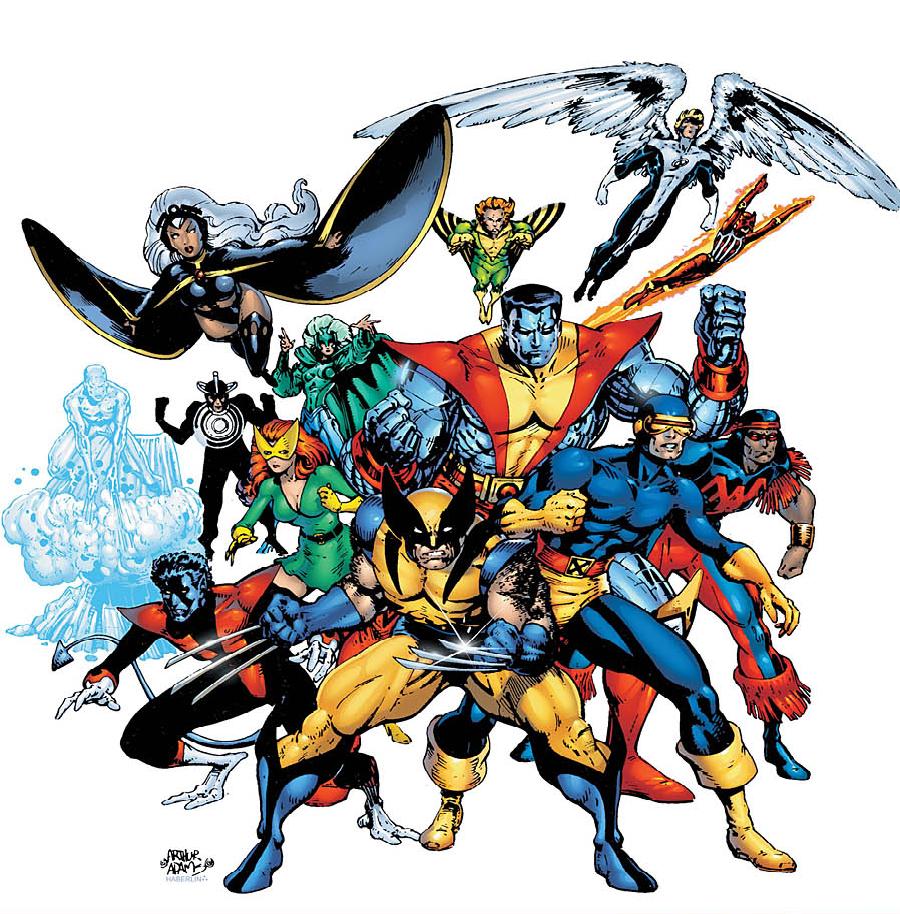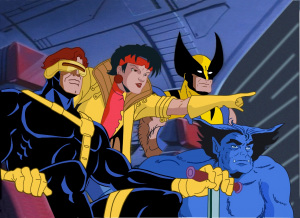
X-Men #1, September 1963
Roll Call
Founding Members: Professor X, Cyclops, Marvel Girl, Beast, Iceman and Angel
Members: Mimic, Changeling, Polaris, Havok, Petra, Sway, Darwin, Vulcan, Nightcrawler, Wolverine, Banshee, Storm, Sunfire, Colossus, Thunderbird, Phoenix, Kitty Pryde, Rogue, Phoenix II, Magneto, Psylocke, Longshot, Dazzler, Forge, Jubilee, Gambit, Bishop, Revanche, Cannonball, Joseph, Cecilia Reyes, Maggot, Marrow, Thunderbird II, Cable, Dani Moonstar, Sage, Emma Frost, Xorn, Chamber, Stacy X, Lifeguard, Slipstream, Northstar, Husk, Juggernaut, Mystique, Warpath, Lady Mastermind, Sabretooh, Omega Sentinel, Armor, Hepzibah, Pixie, Karma, Sunspot, Auroa, Magma, Dr. Nemesis, Box, Magik, Namor, Domino, Boom-Boom, Ariel, Danger, Cypher, Warlock, Fantomex, X-23, Hope Summers, Frenzy, Legion, X-Man, Warbird, Blink, Firestar, M.
Headquarters
The traditional headquarters of the X-Men has been the X-Mansion, Charles Xavier’s family home-turned-private school and superhero base. At times, the X-Men have also operated out of a mystical island in the Bermuda Triangle previously occupied by Magneto, an abandoned town in the Australian Outback, Utopia, an artificial island off the coast of San Fransisco built from the remains of Magneto’s Asteroid M, the New Charles Xavier School for Mutants operating out of an old Weapon X facility, and the newly rebuilt and rechristened Jean Grey School for Higher Learning, on the grounds of the old X-Mansion.
Gadgets and Accessories
The X-Men train in the Danger Room, a facility equipped with advanced alien Shi’ar technology capable of holographically creating a variety of different environments, locations and villains. They traditionally travel via the Blackbird, a customized SR-71 jet.
The X-Men also use Cerebro (aka Cyberno and Cerebra), a device created by Professor X, to track and locate new mutants as well as enhance telepathic abilities for long range use.
Friends and Allies
The New Mutants, X-Factor, X-Force, Excalibur, the Avengers (at times), Fred Duncan, Moira MacTaggert, Empress Lilandra, Stevie Hunter, Tom Corsi, Sharon Friedlander, Amanda Sefton, Callisto, Gateway, Doop.
Foes and Antagonists
Magneto, Apocalypse, Mr. Sinister, the Brotherhood of Evil Mutants, sentient technology, the Hellfire Club, Sentinels, fear, hatred and prejudice.
Movies and Appearances
The X-Men made brief animated appearances in both the 1967 Marvel Superheroes cartoons as well as Spider-Man and His Amazing Friends, before receiving their own TV pilot “Pryde of the X-Men” (which was never picked up). In the 90s, Fox launched an X-Men animated series, and since then, the X-Men have made numerous appearances on the small screen, including X-Men: Evolution and Wolverine and the X-Men.
The X-Men made their big screen debut with 2000’s X-Men, which spawned a film franchise that is still running strong to this day.
One Sentence Origin
Gathered by Professor Xavier, the X-Men are a group of mutants, born with extraordinary abilities, dedicated to the dream of peaceful coexistence between man and mutant, sworn to protect a world that fear and hates them.
Memorable Moment
Uncanny X-Men #141: In the first part of “Days of Future Past”, readers are shown a dystopic future in which most of the X-Men are dead and the survivors live in concentration camps ruled by Sentinels, making clear for the first time the cost of failure should the X-Men fail in their efforts to establish peaceful coexistence with humanity.
Fun Fact
The X-Mansion has been destroyed (and subsequently rebuilt) three times: first, by alien Sidri Hunters in Uncanny X-Men #154, then by Mr. Sinister in Uncanny X-Men #243, and most recently, by Sentienls during “Messiah Complex”.
Austin’s Analysis
The X-Men account for one of the strangest Marvel Comics publishing stories. At one point cancelled, their series barely limping along as a reprint title, the X-Men were reborn with a new roster that steadily climbed the sales charts until the series spawned an entire franchise, including what remains the highest selling single issue of a comic book of all time, leading to an era in which the X-Men were consistently the best selling characters in comics. Without the X-Men, it’s entirely possible Marvel may not have emerged from its mid-90s bankruptcy, and without the original X-Men film in 2000 (which, along with Blade, is often credited with wiping the comic book movie slate clean after the Batman & Robin debacle) , it’s entirely possible we never would have had the Marvel Cinematic Universe and Avengers, the current highest grossing film of all time.
When Stan Lee, along with artist Jack Kirby, started X-Men back in 1963, it was born, in part, out of desperation: after cosmic rays, gamma bombs, radioactive spiders and straight-up mythological gods, Lee was finding it hard to come up with new origin stories for the fantastic abilities of Marvel’s characters. The X-Men, Lee decided, would be mutants, otherwise normal humans born with a genetic mutation that granted them extraordinary abilities. No longer did he need radioactivity or random coincidences to create new heroes, they could just be born that way. Unfortunately, Lee never did much with the idea beyond introducing it: X-Men, even from the beginning, felt like one of the also-rans of Marvel’s 60s-era Renaissance, and while he eventually hit on the idea of mutants as a stand-in for outcasts of all shapes and sizes, he was on his way off the title at that point (Kirby was already down to just providing layouts, and would leave even before Lee), and though Neal Adams artistically reinvigorated the book later in the 60s, it wasn’t enough to stave off cancellation.
In stepped Len Wein, Dave Cockrum and Chris Claremont. Looking to revitalize the X-Men with a new, more international cast, Wein and Cockrum released Giant-Size X-Men #1, passing the torch from the original X-Men to a new group of characters, including a one-off Hulk antagonist by the name of Wolverine. Shortly thereafter, X-Men resumed publishing original stories, now featuring the new team (along with holdover Cyclops), with issue #94, under the guidance of new writer Chris Claremont. Under Claremont and first Cockrum, then John Byrne, X-Men became a cult classic, then a smash success, and Claremont and Byrne’s collaboration on the title, including the classic “Dark Phoenix Saga” and “Days of Future Past” stories (both of which have inspired their own X-Men films), still stand as one of the best sustained runs in superhero comics. From there, the X-Men spawned a spin-off title, New Mutants (featuring a new group of mutants who, like the original X-Men, were students), then another, and by the height of the comic sales boom in the 90s, there were dozens of X-Men comics routinely topping the sales charts.
Much of that success can be attributed to the metaphor at the heart of the concept, the one Stan Lee only touched on briefly back in the day: sworn to protect a world that fears and hates them, dedicated to the dream that man and mutant can live together in peaceful co-existence, they X-Men are, ultimately, outcasts.The X-Men’s struggle for acceptance, to be judged solely on the content of their characters, can be read as metaphor for the similar struggle of anyone of any race, religion, gender or sexuality. Or that struggle can simply be a stand-in for every lonely kid who doesn’t quite fit in with the cool crowd, who gets picked on or left out just for being different. That’s the key to the appeal of the X-Men, and to their commercial success: nearly everyone has felt like an outcast at one point or another, and thus, found both kinship and wish fulfillment in the pages of X-Men comics.
Because, of course, the X-Men aren’t just outcasts, they’re also superheroes with fantastic powers, awesome bodies, and cool gadgets, who get to fight evil and journey to fantastic worlds. After all, what outcast wouldn’t want to live with a ton of friends in a mansion that comes with its own Holodeck?






